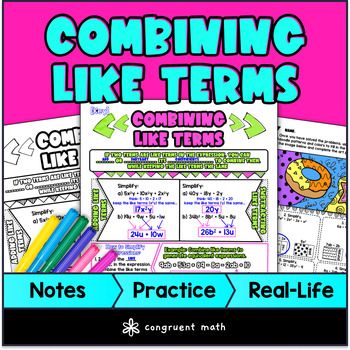Want more ideas and freebies?
Get my free resource library with digital & print activities—plus tips over email.
Join for Free Resources →
$4.25
Have you ever wondered how to teach combining like terms for 6th or 7th grade?
Use this artistic, real-life lesson plan to teach your students about combining like terms. Students will learn about what like terms are, how to combine them, and how to simplify expressions in order to solve real-world problems. The lesson plan includes artistic, interactive guided notes, a check for understanding, and practice with doodle & color by number activity, along with a maze worksheet. The lesson concludes with a real-life application of combining like terms. It shows students how restaurants communicate phone orders under pressure, simplifying expressions to tally up orders quickly and accurately.

$4.25
After this lesson, students will be able to:
Note: This lesson plan features positive numbers only, and doesn’t cover the distributive property. See my distributive property lesson plan for that!
Before this lesson, students should be familiar with:
If you’re looking for digital practice for combining like terms, try my Pixel Art activities in Google Sheets. Every answer is automatically checked, and correct answers unlock parts of a mystery picture. It’s incredibly fun, and a powerful tool for differentiation. There’s winter and spring versions perfect for additional practice.
A fun, no-prep way to practice combining like terms is Doodle & Color by Number — it's a fresh take on color by number or color by code. It includes 2 levels of practice, and is available free.
Like terms in math are terms that have the same variable(s) raised to the same power. For example, 3x and 5x are like terms, but 3x and 5y are not like terms. Combining like terms involves simplifying an expression by adding or subtracting terms that are like terms.
A variable is a symbol that represents a value that can change, whereas a coefficient is the numerical factor of a term that is multiplied by the variable. In other words, a variable is an unknown quantity that can take on different values, while a coefficient is a known constant that is multiplied by the variable.
A term is a single numerical or algebraic expression that is separated by a plus or minus sign. On the other hand, an expression is a group of terms, separated by plus or minus signs or parentheses, that can be simplified or evaluated.
Combining like terms means to simplify an algebraic expression by adding or subtracting terms that have the same variable raised to the same power. By combining like terms, the expression becomes simpler and easier to work with.
To simplify an expression using like terms, you first need to identify which terms have the same variable(s) and exponent(s). Then, you can combine those terms by adding or subtracting them.
For example:
3x + 2y - 4x - y.3x and -4x, and 2y and -y.3x and -4x gives us -x, and combining 2y and -y gives us y.-x + y.If you’re looking for a more visual explainer for your students, here’s a useful Khan Academy video:
Combining like terms can help with real-life situations by simplifying complex expressions and making them easier to work with. For example, in a restaurant, orders can be represented as expressions, and combining like terms can help tally up orders quickly and accurately. In general, combining like terms can help us better understand and analyze real-world situations that involve algebraic expressions.
Here are some examples of real-world situations where combining like terms can be useful:
By simplifying complex expressions, we can better understand and analyze real-world situations that involve algebraic expressions.
Get my free resource library with digital & print activities—plus tips over email.
Join for Free Resources →